Lessons from Two Plagues
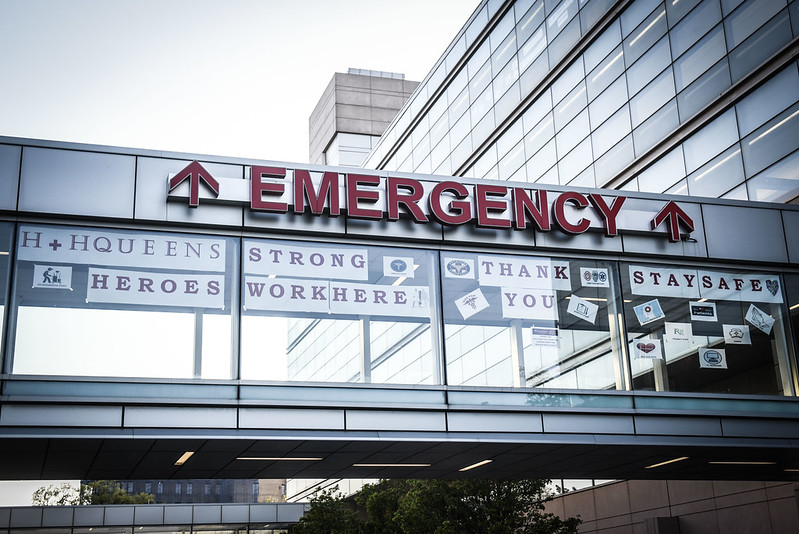
(photo: Michael Appleton/Mayoral Photography Office)
My career in public health and health care is bookended by plagues. I graduated from college in the 1980s and moved to the West Coast. It was a time of freedom and fun and I was living what felt then like an “adult” life; I had a job, my own apartment, a car, a dog, a boyfriend. Life was good.
But something dark and sad was hovering around me at the same time. The HIV/AIDS pandemic was in full effect. By 1990, more than 120,000 Americans had died of the mysterious disease. I knew people who were sick or dead. I had to get involved.
I started volunteering with the Northwest AIDS Foundation doing outreach and education. It was the first time I’d heard of the field of public health. I didn’t really know what it was, but the smart people and leaders around me had studied it. I’d always been interested in politics and it seemed like the place where politics intersected with medicine, so I was hooked. Off to grad school I went and I’ve been working to improve health care ever since.
Thirty years later, we find ourselves in the midst of another pandemic with echoes of the HIV/AIDS crisis:
Fear. The early days of HIV/AIDS were terrifying. Did you already have it? Would you get it? Would you die? What caused it? Today, every sneeze or cough, many from seasonal allergies, causes worry. It’s scary to touch anything — even hug our own families — or go to the supermarket.
No vaccine. In 1984, the Health and Human Services Secretary announced the discovery of the virus that causes AIDS and predicted a vaccine would be available by 1986. Experts are similarly forecasting it will be a year or two until we have an effective COVID-19 vaccine. It’s 2020, and there is still no vaccine for HIV.
Stigma. Would things have been different in the U.S. had HIV/AIDS not mainly affected gay men, people of color, and IV-drug users in the early days? Without question, discrimination and hate played a big role in the slow response to that pandemic. COVID-19 has prompted a resurgence of racism and xenophobia, especially against Asian-Americans. Early on, AIDS was called the “gay cancer.” President Trump often calls COVID-19 the “Chinese virus.”
Government failures. The government has blood on its hands for both AIDS and COVID-19 deaths. The first federal government report on AIDS came out in 1981. It infamously took four years and 12,000 American deaths before President Reagan even uttered the word “AIDS.” The federal government’s response to COVID-19 has been slow and inept. The list of failures includes a lack of testing capacity; inadequate protective equipment and ventilator supplies; failures to contact trace and isolate exposed people; and mixed and confusing public messaging.
Other similarities, however, give me hope. Then and now, we’ve witnessed acts of bravery and courage. People are putting their own lives on the line to save others. Scientists, doctors, nurses, and other healthcare workers have demanded answers and fought for resources. They’ve provided care when they could and comfort when that was all that was possible.
Medicine and science have advanced. HIV/AIDS is no longer an automatic death sentence. We don’t have a cure or a vaccine, but we have treatments that can make AIDS a manageable chronic disease and even prevent transmission. Obstacles to accessing and affording those medications remain, but at least the treatments exist. And today, some of the smartest minds are working on vaccines and treatments for COVID-19.
AIDS forced marginalized people to unify and fight for their lives. As a result, we saw greater visibility, acceptance, and enhanced rights for LGBT people. The race and class differences so glaringly on display with COVID-19 should force us to again confront structural inequities and repair them.
I see hope and humanity in the many Americans showing genuine empathy and caring for others in the community: sewing and donating masks to protect essential workers, delivering groceries to elderly neighbors, supporting local businesses, and more.
Our inadequate response to the HIV/AIDS crisis is a shameful stain on our nation’s history. But we got through the peak of the AIDS crisis — not unscathed or unchanged, but we got through it. We’ll get through this, too.
Already, COVID-19 has killed more than 22,000 people in New York and more than 328,000 around the globe. As with the HIV/AIDS pandemic, things will get worse before they get better. It’s hard to know when and how our current crisis will end and what the future will look like. But we do know what safely getting to a new normal will require: widespread testing, capacity for effective contact tracing, and action that’s guided by facts and science.
As COVID-19 continues to plague us, we can and we must do better. As the old AIDS rallying cry went, “silence equals death, action equals life.”
***
David Sandman is President and CEO of the New York State Health Foundation. On Twitter @DavidSandman1 & @nys_health.
***
Have an op-ed idea or submission for Gotham Gazette? Email This email address is being protected from spambots. You need JavaScript enabled to view it.
No to Austerity, Yes to Efficiency and Fairness: Getting Our Budget Priorities Straight for a Strong Post-COVID New York
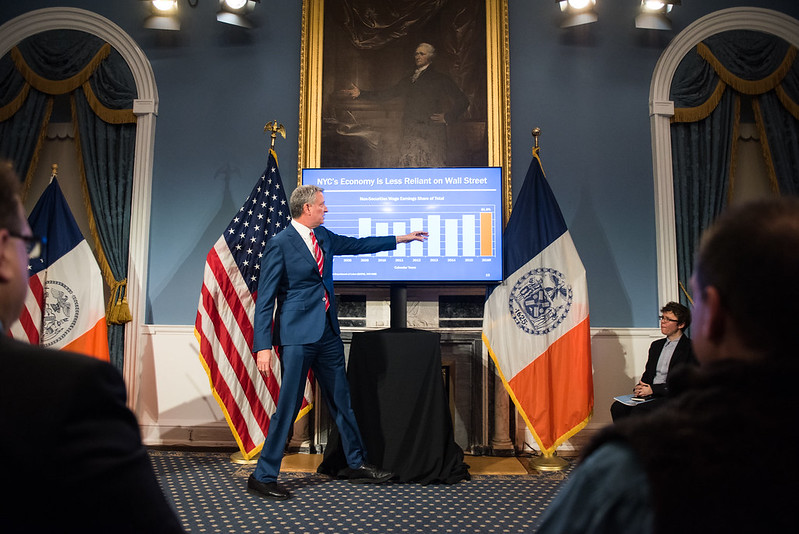
Major budget questions loom as coronavirus takes its toll (photo: Edwin J. Torres/ Mayor's Office)
As we work to show COVID the door, tough budget decisions are ahead. Governments at every level are grappling with the unprecedented toll this pandemic has had on the economy.
COVID has laid bare structural inequities too stark to ignore. While some work comfortably from home, others put themselves in danger on the front lines. While some flee to the Hamptons, others pass the virus between family members in cramped New York City apartments.
These choices become even more stark when we take a cold, hard look at post-coronavirus state and municipal budgets. New York State is facing a $10-$15 billion budget deficit. New York City projects a $7.4 billion loss in tax revenue.
Where should we go to fill the budget gaps?
Our executives have given us hints of what they want to do. We are told that painful cuts are necessary, that sacrifices must be made.
Mayor de Blasio already took a scythe to just about every program with the prefix summer including the Summer Youth Employment Program, a program that provides summer jobs for at-risk teenagers. He has also cut services that affect our daily lives, like trash pickup days and electronics recycling.
Governor Cuomo pushed to cut health-care funding in this year’s budget, even as our public hospitals struggle to treat an influx of coronavirus patients, and we’re told to wait with baited breath for more cuts to come.
The mayor continually refuses to lessen property tax burdens on low- and middle-class homeowners and renters, many of whom are bearing the brunt of COVID’s pain, while the governor has refused to consider revenue raisers on ultra-millionaires, billionaires, and large corporations, many of whom are left unaffected by the virus’ scourge.
We believe these are misguided decisions. We reject the choice between austerity budgeting and a tax burden shouldered by low- and middle-income New Yorkers.
Instead, we need an honest assessment of how we can raise revenues by looking to those who can afford to pay their fair share.
The very wealthiest New Yorkers will not face eviction or foreclosure, like so many other New Yorkers. They will not struggle to access unemployment benefits. They will wait out the storm in second homes.
As a matter of basic fairness, these individuals less impacted by COVID can and should contribute more.
We should also look at corporations that have profited specifically because of this pandemic. These large corporations can and should pay more to rebuild our economy when this is all over.
Passing austerity budgets that cut essential services will only doubly punish our frontline workers and those struggling to make ends meet during and after this pandemic. After all, our essential workers — EMS, police, firefighters, Parks Department employees, grocery store workers, transit workers, nurses, doctors, and so many others — are about 40% people of color; 75% of whom live in the so-called outer boroughs. One-third of our frontline workers are from low-income households.
An austerity approach will inevitably push our city deeper into recession and make it even harder to dig out of this financial hole.
In addition to revenue raisers on those who can afford it, we need substantial federal funds and can borrow up to 20% of the budget from the Federal Reserve’s COVID-19 emergency lending program.
Finally, we also must take a hard look at the waste in our budgets. The New York City budget has ballooned by $20 billion in the last six years alone. The state budget is certainly not immune to wasteful spending either.
Instead of making cuts to hospitals, CUNY, and summer employment, we need to look at the programs with unproven impact, the spending that doesn’t go directly into communities.
For example, procurement contracts make up nearly 40% of the city budget’s recent growth. These contracts should be reviewed and scrapped or renegotiated as necessary. In 2018, the Independent Budget Office suggested that simply switching to open source software could save the city $30 million per year.
For every wasteful or unproven program we know about, there may be many more that we haven’t yet identified, in part for lack of looking close enough. These budgets need to be scrutinized and every revenue-raising option must be explored before we cut a single dollar to any program that working-class New Yorkers rely on.
This pandemic has put us through the wringer in the most brutal way. All of us are reflecting on what kind of society we want to be when we emerge from this dark time.
Our post-COVID government budgets will demonstrate our values. We stand for a New York City and State that cares for its people and lifts up those who need it most.
***
State Senator Andrew Gounardes and City Council Member Justin Brannan represent parts of Brooklyn. On Twitter @agounardes & @JustinBrannan.
***
Have an op-ed idea or submission for Gotham Gazette? Email This email address is being protected from spambots. You need JavaScript enabled to view it.
To Prepare for Future Crises and Recover from This One, Bring the Supply Chain Back to the United States
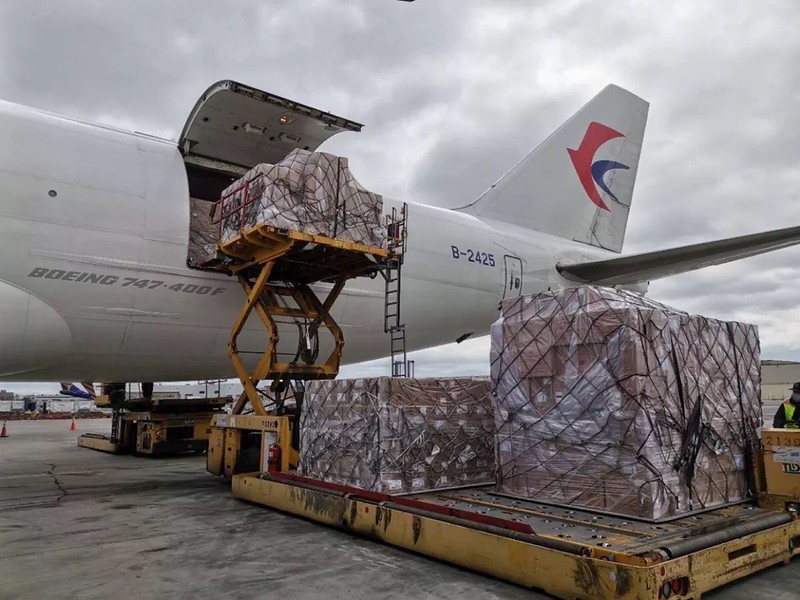
Ventilators arriving in New York from China (photo: governor's office)
It’s been incredibly horrifying to watch scenes unfolding at New York City’s public hospitals as medical staff struggle to keep pace with the coronavirus pandemic. Although doctors and nurses—from Kings County Hospital in Brooklyn to Jacobi in the Bronx—have shown remarkable courage under fire, they are under siege from an invisible enemy that shows no mercy to those in its path.
The situation has been tough for my mother to bear. She’s a home health aide working on the frontlines to protect some of New York’s most vulnerable residents—the developmentally disabled. But she’s also a refugee who fled a civil war in Uganda more than three decades ago and gave birth to my younger sister and me at one of the city’s hardest hit public hospitals, Elmhurst.
As we grapple with our country’s coronavirus reckoning there are elements that are reminiscent of the war-torn Uganda she escaped. The uncertainty of when life will return to some sense of normalcy. The shadow of death that seems to lurk all around us. The mental anguish that has gripped America’s consciousness.
Yet, there is one element of this crisis that is deeply vexing: why were we so unprepared, why didn’t we have enough ventilators or personal protective equipment? When New York and other states turned to the federal government, President Trump’s response was effectively: you’re on your own. Besides the ineptitude of the president, the answers don’t only lie in Washington, but also in corporate boardrooms across America.
Over the past four decades, our country’s manufacturers have been blazing a trail across the world seeking places—mostly emerging economies—to produce their goods for much cheaper than they would in the United States. This intense focus on cheaper cost of goods and maximizing profits is a result of a shift in America’s corporate culture that sought to place the maximization of shareholder value above all other stakeholders—employees, customers, suppliers, communities, etc. As the labor arbitrage took place, corporate profits began to soar and much of the country’s manufacturing capacity began to disappear. It’s a correlation that’s difficult to ignore.
The end results weren’t only cheaper goods and lower costs, but a long list of supply chains that no longer existed in the United States—including personal protective equipment and ventilators, just to name a few. This dynamic has led to an erosion of well-paying middle-class jobs and threatens our national security. In 1940, 60% of New York City’s workforce was employed in manufacturing. Today, that number is 16%. We are now relying mostly on China to supply us with critical equipment to save American lives.
This pandemic should not only serve as a call to action for policymakers in Washington to enhance the nation's public health infrastructure, but to also demand American corporations shift away from this myopic view of shareholder supremacy. This should begin with repatriating supply chains deemed critical to America’s national security.
Americans should make the equipment that will save their lives. This includes manufacturing PPE, pharmaceuticals, tests, and medical devices on our shores so that we are prepared for future disease outbreaks and crises that disrupt the world. The government must take the lead to invest in medical manufacturing to bolster our national supply to prevent future shortages on equipment. And as we move out past this crisis, we must look for ways to modernize our manufacturing industry to meet our country’s needs while moving us forward. Specifically, we need to focus on greening manufacturing—retrofitting former manufacturing plants to become more environmentally friendly, producing renewable energy infrastructure, and better training American workers would create jobs and address environmental hazards.
Our government must do more to hold accountable American corporations that ship jobs overseas. American multinationals that will not repatriate should be taxed at significantly higher rates for shipping jobs outside our country. This revenue is sorely needed as we face this economic crisis. Also, corporations that seek bailout funds related to the pandemic must demonstrate that the majority of their workforce is American; otherwise they should be deemed ineligible. And as we move forward, EPA regulations must be strengthened to ensure manufacturing plants are not environmentally harming the surrounding communities.
We have a long way toward recovery, but recovery has to start with a reflection on why our country was so woefully unprepared for this crisis. We must ensure that all Americans, and most importantly corporate America, contribute to the rebuilding of our nation.
***
Adem Bunkeddeko is a candidate for Congress in New York’s 9th District, covering parts of Brooklyn. On Twitter @adembunkeddeko.
***
Have an op-ed idea or submission for Gotham Gazette? Email This email address is being protected from spambots. You need JavaScript enabled to view it.
A CLEAR Path Forward on Emergency Preparedness
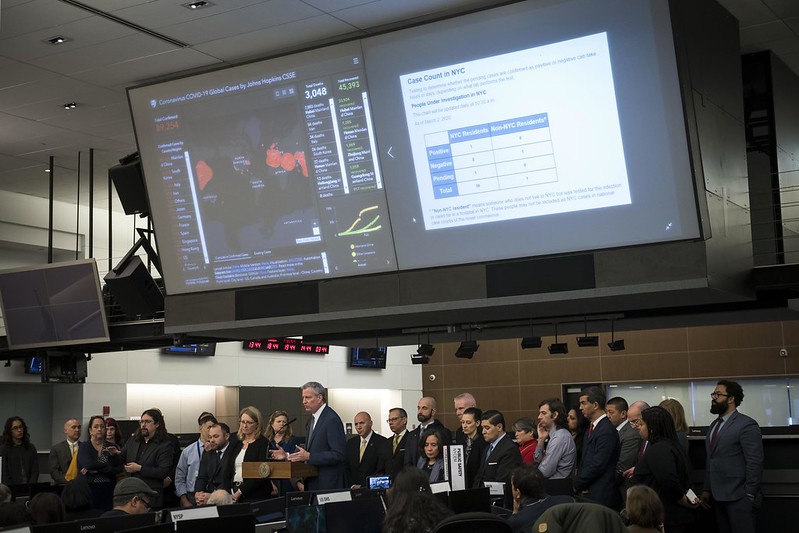
Mayor de Blasio holds an emergency management briefing (photo: Ed Reed/Mayor's Office)
I’m writing this from my living room. My three-month-old daughter is across the room, sleeping in her activity gym. My wife is watching television. This should be another normal day, but all of us, including you reading this, knows it's not. Our daughter has barely seen her grandparents since February. My wife hasn't seen the outside world in almost two months. Aside from a few stressful trips along empty streets to the grocery store, neither have I.
Nothing about this pandemic has been normal — not even our response. The COVID-19 outbreak rekindles the darkness of Hurricane Sandy. No one knew what to do or where to go. By the time the government acted, it was too late. No master plan existed to deal with prolonged school closures, hold an election after a disaster, and mobilize large-scale relief efforts. Tragically that is still true.
There was no plan in place before the first coronavirus case was confirmed in New York City. The Greatest City on Earth is letting its people down time and time again because we fail to prepare for the next inevitable disaster.
The City of New York needs to do better, and I have a plan to make that happen. My first bill introduced to the New York City Council will be the New York Create and Learn Emergency Action Response Act. The NY CLEAR Act would create a five-level, color-coded alert system based on the post-9/11 federal system. New Yorkers should be able to know green means everything is smooth sailing; blue could indicate a closure or restriction due to standard winter storms; and red would mean the city is shut down in its current form.
The NY CLEAR Act would live up to its name by being concise and easily understood. It would be a universal language so our diverse communities all understand the severity of a situation. No matter which of New York City’s more than 200 languages you speak, you’d know that green means everything is fine — the city is safe. New Yorkers would know it’s safe to enjoy a park, go to work, or get on a subway that’s as unreliable as normal.
Blue would indicate the city is monitoring an evolving situation. This code should be in place when we send more police officers to Penn Station and other crowded areas after a terror attack, as we did the night of the 2015 Paris shooting. It would give New Yorkers a sense that the city is aware of a threat and is working to address it. Internally, blue signals to the Office of Emergency Management it must collect data on the event to adapt the city’s standard response plan.
Yellow means that threat is now inevitable. Hospital administrators would start implementing plans to increase supplies and staff. Alternate side parking rules would be suspended, while garbage pickups and mass transit service would be modified. Small businesses should take yellow as a warning that their hours might change or close completely.
Orange would mean the emergency is already happening — such as when the number of positive COVID-19 cases spiked over 1,000. Schools, courts, and all non-essential offices would immediately close. If severe weather has caused us to go orange, evacuation centers are opened.
Red tells New Yorkers that leaving their home is life-threatening. At this point, each agency’s specific emergency plan would go into place. Pre-identified roads will close to non-emergency vehicle traffic. City government should be ready to deliver food, protective equipment, and other life-saving materials door-to-door.
Imagine the number of cases we could have prevented, the number of lives saved, if city government had a wholesale plan in place for when a crisis strikes. Instead, our collective anxiety was compounded by the government operating on the fly — obviously without a serious plan for this type of situation and without the people of New York knowing how or being prepared to respond.
The NY CLEAR Act will make New Yorkers safer. Informational posters will be clearly displayed at every workplace alongside other key documents such as the Department of Labor’s “know your rights” sheet. Every New York City hotel room would provide a mandated pamphlet, so visitors can learn the emergency system quickly.The NY CLEAR Act should also be taught at an age-appropriate level in classrooms so young people will know how to adapt in the event of an emergency.
It is critical every New Yorker knows how to prepare for an emergency, and how to respond when the time comes. They deserve for New York City to declare an emergency at the right time, and for agencies to be held accountable for their responses. The NY CLEAR Act will mandate a hearing any time the city goes to yellow or higher. When a service is suspended, or when certain plans are put into place, it should require the city to conduct a wholesale look at whether protocols were properly followed and what we can learn to improve our response.
Crises have historically challenged us, well after the actual tragedy. We are judged both by our response in the moment as well as what we did to mitigate future catastrophes. Hurricane Sandy and COVID-19 both cost us too many lives. It’s time we learn our lesson and prepare. The next disaster will come. Whether or not we are ready, that much is clear.
***
Nick Roloson is a candidate for the New York City Council in District 22, in Queens. On Twitter @nickroloson.
***
Have an op-ed idea or submission for Gotham Gazette? Email This email address is being protected from spambots. You need JavaScript enabled to view it.
It’s Actually the Perfect Time for City Government to Invest in Housing
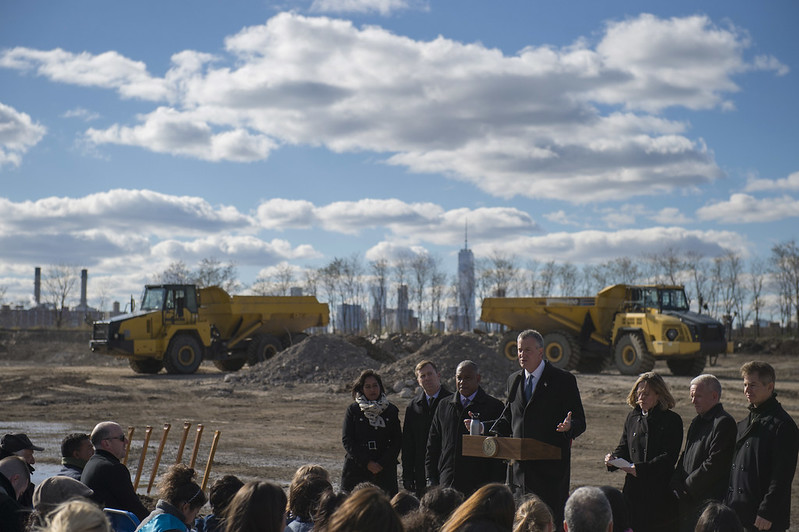
Mayor de Blasio makes a housing announcement (photo: Ed Reed/Mayor's Office)
In the wake of the economic devastation caused by the coronavirus shutdown, Mayor de Blasio must find budget savings anywhere he can, while still advancing his mission to make New York “the fairest big city” in America.
It won’t be easy. But the sudden drop in tax revenue should not stop the mayor from continuing to make one smart investment: creating new affordable housing.
With the pandemic exposing the full extent of the city’s homeless crisis, now is exactly the time to create more affordable and supportive housing, as well as high-quality shelter. Doing so can sharply reduce exorbitant spending on emergency homeless hotels, create good-paying jobs when we need them most, and end the terrible damage homelessness has inflicted on a generation of children.
New York City cannot afford to miss what is a once-in-a-lifetime opportunity.
Before the COVID-19 pandemic disrupted the city’s economy, the mayor found himself stuck in an unwinnable war against homelessness.
Mayor de Blasio created thousands of new, locally-funded rental vouchers for homeless families, helping many return to permanent housing. But the lowest rental housing vacancy rate in decades meant too many of the vouchers went unused, unable to counter the law of supply and demand.
The mayor also launched a record-breaking affordable housing production initiative that likewise helped thousands of homeless people find homes again. But with so many New Yorkers becoming homeless each night, the housing just couldn’t be built fast enough.
The pandemic has changed all this. And while the economic repercussions will be devastating, they also present a promising opportunity for change.
No matter what we do, New York City is likely losing residents now and into the immediate future. With the drop in demand, thousands of overleveraged properties will become available for purchase and conversion to affordable housing. With far fewer tourists visiting the city for the foreseeable future, newly superfluous hotels will be available for pennies on the dollar. Otherwise healthy apartment buildings will need formerly homeless tenants with rent vouchers those tenants can finally use.
With these new conditions suddenly in place, the mayor finally has the chance to lay the foundation for his successor to end widespread homelessness in New York City.
To do so, the city should first maintain – or even increase – capital investment in affordable housing production this year. The city borrows to fund this housing investment, so it has an outsized economic effect: the money creates housing (and jobs) today, but the bonds are paid back over decades. Fortunately, at this time interest rates are low, and the share of the city’s budget going toward borrowing costs is far below the 15% fiscal experts recommend as a cap. In short, we can afford to do this.
The administration has instead proposed slashing the capital housing budget by 40% — roughly half-a-billion dollars annually — this year and next. These cuts will delay the creation of thousands of new affordable housing units right when we need them most, and just as the cost of acquisition and development is falling.
Cutting half-a-billion dollars from the capital budget sounds like a lot of savings. But because the money for long-term investments like affordable housing is borrowed, the cut will only reduce the city’s cost of paying the money back — less than $50 million a year in savings. But in reality, we won’t save a thing. If these cuts go through, the next mayor will end up spending even more sheltering New Yorkers who remained homeless because the housing was never built.
Of course it’s not enough just to restore the cuts to affordable housing. Despite its newly straitened circumstances, the city should stick to the mayor’s original vision and keep providing rental vouchers to homeless households. It must redirect capital dollars to acquire newly available distressed properties. And it should build housing for the people who need it most: homeless, senior, and very poor New Yorkers, because housing vulnerable people has been proven, over and over again, to reduce public spending on health care, shelter, and other expensive emergency interventions.
Our city’s terrible homeless crisis demands a renewed commitment to creating more housing. Fortunately, few economic activities generate more benefits: such an effort will bring precisely the kinds of increased jobs and consumer spending we need right now to restore the city’s economy. It is the most effective and cost-efficient option available to the mayor to spur the city’s comeback. At the same time, no investment will do more to cement the mayor’s legacy of correcting long-standing systemic inequities that have plagued the city for decades.
***
Ted Houghton is the President of Gateway Housing, the former Executive Deputy Commissioner of New York State Homes and Community Renewal and former Executive Director of the Supportive Housing Network of New York. On Twitter @Gateway_Housing.
***
Have an op-ed idea or submission for Gotham Gazette? Email This email address is being protected from spambots. You need JavaScript enabled to view it.
Coronavirus, Climate Change and Coming Together Amid Catastrophe

The current crisis reminds us of the past and warns us about the future (photo: Kevin P. Coughlin/Governor's Office)
Everyone on Long Island remembers how it felt during Hurricane Sandy. We were paralyzed, waiting for the storm to pass, fearing for our families, homes, and basic needs. When the skies finally cleared, and we saw the scale of the destruction, it was clear that no individual one of us was strong enough, connected enough, or resourced enough to recover alone. We needed each other, we needed our community, we needed to come together.
Now, we’re facing another disaster, this one a global pandemic that has already sickened millions, killed hundreds of thousands, and left one in five Americans unemployed. We need to remember those lessons learned after Sandy. We must understand that we’re in this together.
The people who were struggling the most to get by before the pandemic started are the ones suffering the most now. Hourly and gig economy workers, the elderly, incarcerated and homeless people, and low-income communities of color are experiencing the most death and economic devastation.
They will also be the ones left behind after the next climate disaster. Long Island is one of the most segregated regions in the country, so it’s no surprise that COVID-19 cases and climate vulnerability are both staggeringly high in communities of color.
Part of this is because of climate and environmental injustice. A new study from Harvard University has found that exposure to air pollution heightens a person’s risk of dying from COVID-19. Here on Long Island, years of housing and environmental policy have ensured that black communities are stuck next to the worst polluting infrastructure sites. It’s no surprise that years of breathing in car and truck emissions can weaken a person’s lungs and make them more susceptible to COVID-19.
We can learn our lesson from Sandy and provide relief now by preparing for the future. Recovery funding and programs should be directed towards the most impacted communities, and should help reduce environmental pollution and thus COVID-19 and other vulnerabilities. As soon as it’s safe to do so, we can put people back to work by building renewable-energy and climate-resilient infrastructure, and target hiring and economic development for communities experiencing the most job and wage loss right now.
And, we can work to avoid the worst climate disasters. Many upcoming climate events are already “locked in,” but we can still come together to avoid the worst of the worst. New York now has one of the strongest climate laws in the country, the Climate Leadership and Community Protection Act. The CLCPA is one of the few laws that calls for emission reductions in line with scientific recommendations to avoid the worst climate outcomes. We can hold our government accountable to the law -- for example, by ensuring it continues to work on the emissions reduction plan during the PAUSE order -- to lessen the risk of worst-case scenario climate disasters in the future.
Reflecting on Sandy in light of the current moment, it’s clear that we did not learn enough about how to come together to keep people safe. People today are dying alone in overcrowded hospitals and nursing homes because our state and federal governments did not take the necessary action to protect people from catastrophe. We cannot let this happen again — not in our lifetimes, and not for our children, either.
As we recover from this pandemic, we must link the recovery with the solutions to the climate crisis. We should be investing in a system that places people before profits and addresses the root causes with bold effective action. We are in this together -- as we have seen, the cost of doing nothing is everything.
***
Lisa Tyson is Director of the Long Island Progressive Coalition, which works for racial justice, building community wealth, and realizing a just transition to a renewable energy future. On Twitter @LisaTysonLIPC.
***
Have an op-ed idea or submission for Gotham Gazette? Email This email address is being protected from spambots. You need JavaScript enabled to view it.
As Construction Sites Reopen, Access to Safety Training Must Too

Construction workers will be among the first back to work (photo: governor's office)
In the blink of an eye, COVID-19 brought most of New York City’s construction industry to a halt, leaving thousands of hardworking individuals jobless and struggling to make ends meet. Fortunately, Governor Cuomo recently announced a phased plan to reopen the construction industry, which will create an increased demand for workers.
But we can’t forget that as a requirement for employment in New York City’s industry, many construction workers and job applicants will need to complete additional safety training requirements.
Local Law 196, which required construction workers to have 30 hours of Occupational Safety and Health Administration (OSHA) safety training by December 2019, also requires workers to get an additional 10 hours of training – a total of 40 hours – by this September. That’s just a few months away – and thousands of current or prospective workers still need to meet the deadline.
Prior to the first deadline, Building Skills New York partnered with a wide array of local non-profits and other institutions, such as Hostos Community College and Public Housing Communities, to host OSHA-30 training sessions that helped provide free training to more than 300 workers. And of course, we were far from the only ones stepping up. That kind of work all across the city had a real impact on ensuring that more men and women entering the industry had the training and credentials needed to secure good jobs.
But now, with social-distancing mandates in place for the foreseeable future, it is not currently possible to receive OSHA training in a traditional classroom setting. That’s why it is critical for public and private sector partners to take two steps on this issue over the coming weeks.
First, more funding should be made available to connect current and prospective construction workers with virtual OSHA training opportunities. Workforce development groups like Building Skills are already doing this by shifting our digital operations and using remote technology capabilities to hold online OSHA sessions. Amid current virus concerns, this virtual training model is a no-brainer – it protects workers’ health while also giving individuals full access to construction employment opportunities.
Second, public officials should consider taking careful, data-driven steps to planning out a process for reopening in-person site safety training facilities. While OSHA sessions can be held online, other courses – such as the Department of Buildings’ series of 4-hour, 16-hour, and 32-hour scaffold trainings and the Fire Department’s F-60, G-60, S-92, S-93, and S-94 – must be completed in person. Just as state leaders have developed reopening plans for construction and other industries based on guidance from health experts, the same approach could be applied to spaces that previously housed safety training sessions.
Regardless of how we get there, it is incredibly important that nonprofits and other organizations are able to fund any necessary training sessions over the coming weeks and months. As we look to rebuild New York City’s economy, we must take into account individuals who live in underserved communities with an existing history of unemployment and underemployment. Current and prospective workers from across the five boroughs deserve the chance to access the city’s construction sector as new jobs become available.
Despite the city’s current site shutdowns, the construction industry will soon continue to provide real career opportunities for New Yorkers of all backgrounds. And just as public officials have taken a logical, systematic approach to reopening worksites, they must also look to make safety training more accessible to the men and women who will help build the future of our city in the wake of the COVID-19 pandemic. New funding for virtual courses is a great way to help us do that.
Building Skills looks forward to effectively confronting this new challenge alongside our incredible network of industry and non-profit partners – and we know that these efforts will help ensure that challenge is addressed for workers who need our support.
***
David Meade is Executive Director of Building Skills New York. On Twitter @BuildSkillsNY.
***
Have an op-ed idea or submission for Gotham Gazette? Email This email address is being protected from spambots. You need JavaScript enabled to view it.
Underappreciated and Underserved, Immigrant New Yorkers Need the City to Step Up
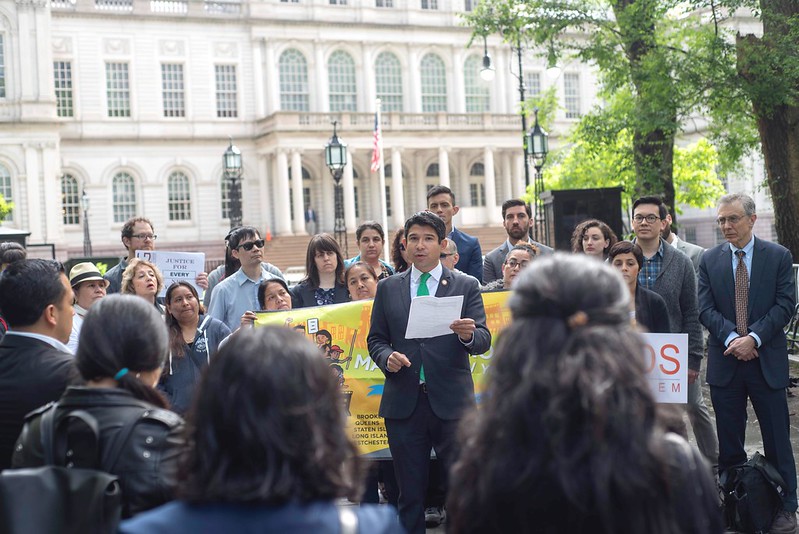
Council Member Carlos Menchaca, the author (photo: John McCarten/City Council)
As in past crises, immigrant New Yorkers are suffering acutely under COVID-19: this time with a cruel twist. While thousands of immigrants work on the frontlines, caring for the sick, cleaning the subways, and keeping us all fed in quarantine, so many are unable to pay rent, keep their businesses afloat, or stay home because of their exclusion from federal relief programs.
That hypocrisy alone should warrant intervention by New York state government, yet it hasn’t. Governor Cuomo has either blamed the federal government for not giving enough aid, or incorrectly claimed, as he did this week, that “the federal government has a number of programs to address” the plight of immigrants already.
The state’s lack of urgency reflects values and priorities as much as fiscal reality. But our city cannot afford to wait for the state to help more than 3 million of our own New Yorkers. We must have the courage to pass a budget that addresses their desperation, primarily because the city’s full recovery depends on it.
In New York City, more than half of immigrants are essential workers, immigrants own half the city’s businesses and contributed $232 billion last year to our GDP. That includes 360,000 undocumented immigrant workers and 48,000 undocumented business owners. A city budget -- due by July 1 -- that excludes immigrants from relief would be astonishingly hypocritical on this basis alone.
It would also be cruel. According to a survey recently conducted by Make the Road New York, nine out of ten immigrant households have at least one earner who has lost a job or income since the pandemic began. Of unemployed respondents, 88% are out of work because of COVID-19. With nine in ten immigrants also renters, more than half were unable to pay rent in April, and nearly every respondent worries they cannot pay in May.
Compounding this economic insecurity is lack of access to government assistance, as undocumented immigrants were largely excluded from federal relief – such as paid sick leave and unemployment benefits – even though they pay billions, annually, in taxes. Of those surveyed, only 15 percent reported receiving any support from the government at all.
Above all, the Trump Administration’s anti-immigrant agenda has proved to be a death sentence for our communities: pre-pandemic expansion of the public charge rule and escalation of immigration enforcement have caused many immigrants to shirk medical care, which puts everyone at risk. All the while, ICE continues to arrest and detain immigrants in COVID-19 infested facilities and the U.S. Department of Justice forces immigration courts to remain open for detained dockets, putting both immigration agents and public defenders at risk.
There is much New York City can do through the budget to help immigrant New Yorkers. Our current situation has exposed the critical gaps our budget fills: funding public defenders for the deportation defense of unaccompanied minors and detained adults; English proficiency classes for New Yorkers to navigate city life and government at all levels; and healthcare programs that are immigrant-led through trusted community partners, to name a few. We must fully renew funding for all immigration legal services and adult literacy programs; allocate funding for culturally sensitive health and mental health-care, and interpretation services like a worker cooperative language bank.
We can also pass existing legislation that would reform our commercial rent market; legalize e-bikes for delivery workers now that state authorization exists; and reform and expand our street vendor licensing system. These bills already enjoy overwhelming City Council support and their passage would send a clear message to immigrant New Yorkers that the city has their backs.
None of these things would come easy, and I appreciate, as a member of the Council’s Budget Negotiating Team, the competing priorities with which we are faced. But immigrants are not a special interest. If we do not secure the well-being of over 3 million New Yorkers, there is no recovery.
It is time for all levels of government to step up and recognize what over 120 grassroots-led mutual aid groups already know: that full recovery depends on the well-being of our immigrant communities. That praise for essential workers is hollow if we exclude most of their ranks from relief. And worse of all, we make a mockery of our collective effort if we leave so many behind.
***
City Council Member Carlos Menchaca represents parts of Brooklyn and chairs the Council’s immigration committee. On Twitter @CMenchaca.
***
Have an op-ed idea or submission for Gotham Gazette? Email This email address is being protected from spambots. You need JavaScript enabled to view it.
What New York City Voters Need to Know About the June Primary Elections
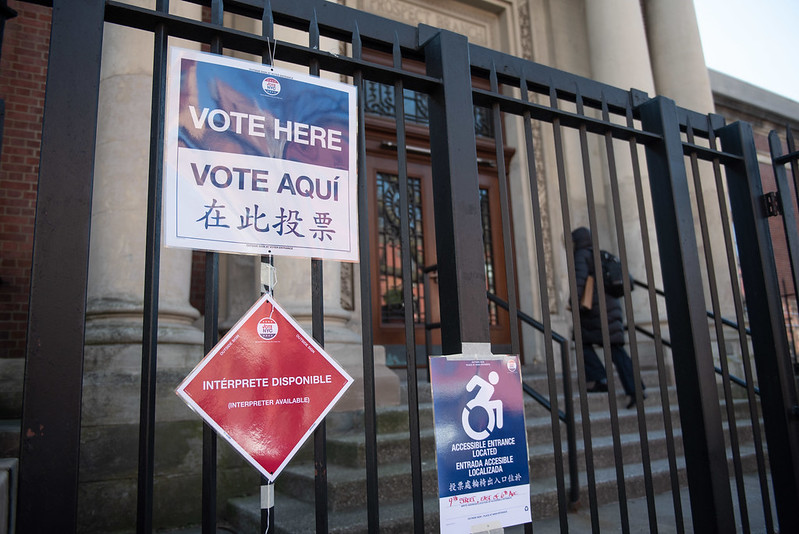
What voters need to know to vote in June (photo: Michael Appleton/Mayor's Office)
The images of Wisconsin voters standing in line last month starkly illustrated how COVID-19 has triggered a health emergency for our democracy. Here in New York, elections have been postponed or canceled in response to the pandemic. We are taking the first steps towards voting in a new way, via mail-in absentee ballots. With all of these rapid changes, it is no wonder voters are confused about what steps they can take to cast a vote safely and help maintain the health of our democratic system.
In response to these unprecedented circumstances, the Mayor’s DemocracyNYC Initiative and the NYC Votes/Campaign Finance Board have convened a consortium of community-based organizations, good government groups, and advocates to get the word out about voting safely to the hardest-hit communities. Our goal is to make sure voters in these underrepresented communities have the information they need to make use of absentee voting as a safe and effective alternative.
Here is the critical guidance New Yorkers need to safely exercise their right to vote -- and to keep our democracy healthy -- on June 23.
First, all eligible voters may cast a ballot by mail. To do so, city voters must request an absentee ballot by June 16. The Board of Elections will mail voters an absentee ballot application this month with a postage-paid return envelope. But there is no reason to wait. We encourage as many voters as possible to request an application online. Requests can be made online at a new website created by the city’s Board of Elections: nycabsentee.com. The application is now available in Spanish, Chinese, Bengali, and Korean.
Absentee ballots will not be mailed out to all voters; only voters who request an absentee ballot will receive one. Thanks to an executive order from Governor Cuomo, anyone who wants to vote absentee due to the coronavirus pandemic should indicate “temporary illness” as the reason for requesting a ballot.
Voting by mail is a safe and effective way to exercise the right to vote during this public health crisis. Governor Cuomo’s executive order allowing all voters to cast a mail-in ballot means New Yorkers will not face the awful choice between voting and protecting their own health that voters in Wisconsin were forced to make.
As New York contemplates re-opening, in-person voting will be available for the voters who need it. The best way to vote in-person is during the early voting period, June 13-21, when fewer people will be at the poll sites. For the health and safety of everyone, especially poll workers, those who can should vote by mail-in ballot.
The second critical point is that primary elections are happening, whether the Democratic presidential primary is held or not (that matter is currently being decided by the courts). Important primary races for Congress, State Legislature, and municipal offices will be decided on June 23. The vast majority of neighborhoods across the city will have at least one primary contest on that absentee ballot.
To vote in most primary elections, voters must be enrolled in the party holding the primary under rules set by the parties. The state’s look-up tool (voterlookup.elections.ny.gov) is the best way to check whether your voter registration and party affiliation status makes you eligible to vote in a primary.
While the path is clear to vote safely by mail in June, we are concerned that New Yorkers will not have that option in November. Governor Cuomo’s order making the risk of contracting coronavirus a valid excuse for voting absentee will expire after the primary election. These changes should be considered for future elections to allow safe and secure voting in November.
Voters should not have to choose between health and enjoying the privileges of citizenship. In time of crisis, it is critical New Yorkers participate in choosing who will lead our city in the coming months and years of rebuilding. We urge all eligible voters to request a mail-in ballot and be a part of making those critical choices on June 23.
The undersigned civic leaders are launching a nonpartisan outreach campaign this week to guide New York voters through the 2020 elections. New Yorkers can request an absentee ballot for the June primaries online at www.nycabsentee.com. To request a ballot by phone, or for help with voting questions, call the Board of Elections hotline 866-VOTE-NYC (1-866-868-3692).
|
Name |
Title |
Organization |
|
Wayne Ho |
President & CEO |
Chinese-American Planning Council (CEC) |
|
Betsy Gotbaum |
Executive Director |
Citizens Union |
|
Prof. Ester Fuchs |
Director |
Columbia University, WhosOntheBallot |
|
Edward Cuesta |
Executive Director |
Dominicanos USA |
|
Eliana Santos |
Director |
Dominicanos USA |
|
Laura Ladd Bierman |
Executive Director |
League of Women Voters of NYS |
|
Karen Cummings |
Community & Govt Affairs Liaison |
LiveOnNY |
|
Laura Wood |
Senior Advisor & General Counsel |
Mayor's DemocracyNYC Initiative |
|
Bitta Mostofi |
Commissioner |
Mayor's Office of Immigrant Affairs |
|
John Park |
Executive Director |
MinKwon Center for Community Action |
|
Amy Loprest |
Executive Director |
NYC Campaign Finance Board |
|
Dr. Sarah Sayeed |
Chair & Executive Director |
NYC Civic Engagement Commission |
|
Megan Ahearn |
Program Director |
NYPIRG |
|
David Estrada |
Executive Director |
Sunset Park Business Improvement District |
|
Jarret Berg |
Co-Founder |
VoteEarlyNY |
***
Have an op-ed idea or submission for Gotham Gazette? Email This email address is being protected from spambots. You need JavaScript enabled to view it.
Let’s Thank All Caregivers, Not Just the Most Visible
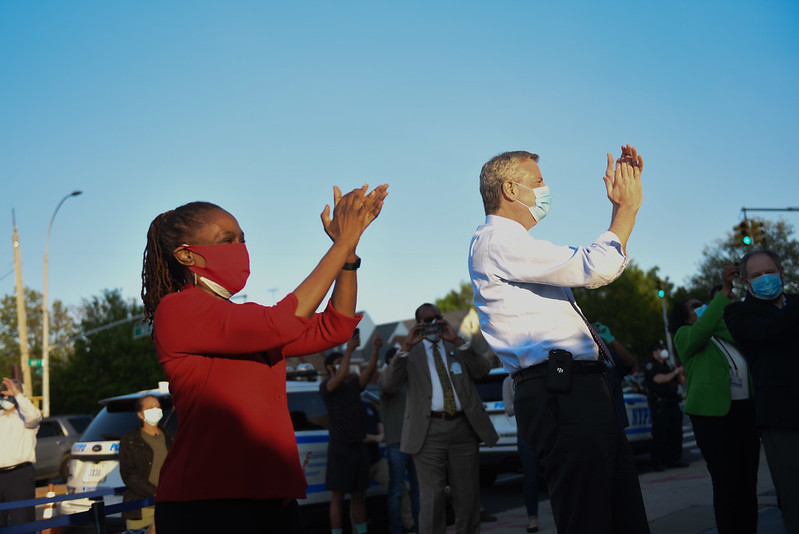
Thanking all caregivers is essential amid the pandemic (photo: Michael Appleton/Mayor's Office)
Long-term care is the fastest growing sector within the health-care industry in New York City, and with 1.2 million New Yorkers now over the age of 65, it will only continue to grow in size and importance over the next 10 years.
Nevertheless, this vital health-care workforce remains largely invisible as most paid long-term care services are provided by direct care workers to homebound individuals. Sadly, when it comes to long-term care, out of sight often means out of mind.
It’s time for our direct care workers — including home health aides, personal care attendants, direct support professionals, and certified nursing assistants — to get the respect and support they deserve. As the lowest-paid workers in the health-care system, typically earning just $21,000 a year, they perform strenuous, isolated work, often without benefits or opportunities for advancement.
Predominantly people of color and immigrants, they too have been rising to the challenge as they continue to care for hundreds of thousands of older people and people with disabilities in their homes and in nursing facilities through the COVID-19 pandemic.
These efforts have clearly helped to reduce the surge in hospitals. Yet, unlike doctors and nurses, who have deservedly received public recognition for their sacrifices, direct care workers have largely been left out of the conversation.
Despite these systemic challenges, there have been some signs of progress amid the COVID-19 pandemic. New York City has designated direct care workers as essential workers, is helping to supply them with personal protective equipment, has opened testing centers for these workers, and has made them eligible for hotel rooms should they need to self-isolate. Recently, the city partnered with One Medical to offer COVID-19 testing and telehealth services, and will prioritize 1199SEIU members and essential workers, many of whom work in long-term care.
Before COVID-19 challenged our systems, city government partnered with the New York Academy of Medicine (NYAM) to convene direct care providers, trade associations, and Local 1199SEIU (which represents approximately 103,000 direct care workers) to better understand and elevate the value of direct care workers in long-term care.
The strategies we developed to address training and recruitment, career pathways, better integration of direct care workers in health-care systems, improved Medicare/Medicaid reimbursement rates, and expanded rights and resources for the direct care workforce are more important than ever before. There is a lot of work left for us to do and it will not be easy. But in the interim, let’s start with the number one issue identified by both workers and providers: Respect.
As COVID-19 forces the nation to rethink and reform its approach to health care, direct care workers must be included as a critical part of a reimagined health-care system. For now, let us celebrate New York City’s direct care workers, and thank them for their service.
***
J. Phillip Thompson is New York City Deputy Mayor for Strategic Policy Initiatives and Judith A. Salerno, MD, MS, is President of The New York Academy of Medicine. On Twitter @NYCMayorsOffice, @DrJudySalerno, & @NYAMNYC.
***
Have an op-ed idea or submission for Gotham Gazette? Email This email address is being protected from spambots. You need JavaScript enabled to view it.
A Bad Deal at the Municipal Credit Union
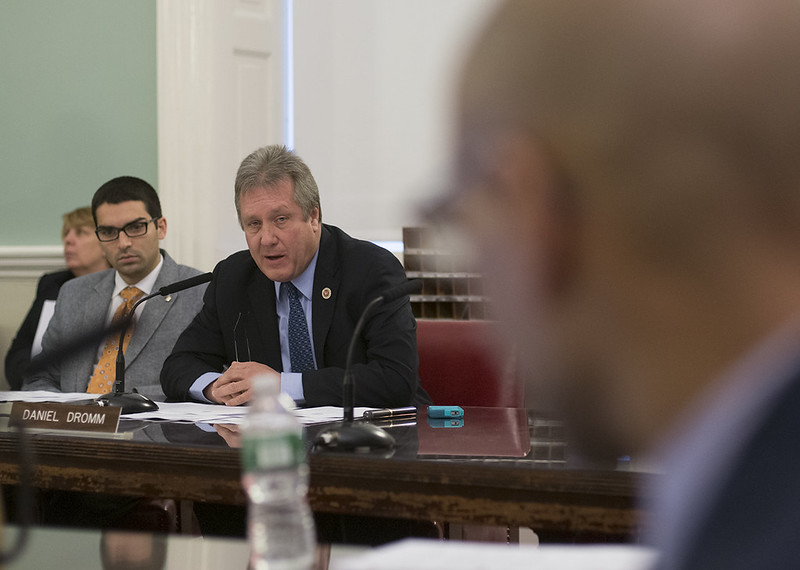
Council Member Dromm, the author (photo: William Alatriste/New York City Council)
As we confront the COVID-19 pandemic in New York, millions of residents face serious financial insecurity, and are worried about how they are going to pay their bills. They are worried about themselves and their loved ones getting sick or not being able to work due to the social distancing regulations in place.
For workers at Municipal Credit Union, the largest credit union in New York, the crisis has only made recent negotiations between management and the union representing them worse.
Over 500,000 city workers depend on MCU for their banking needs, including mortgages, car loans, and checking and savings accounts. Nearly 400 union MCU workers are working hard to ensure that New Yorkers have access to their finances at this crucial and challenging time, but they are also facing the risk of exposure. They need to be assured protection and treatment should they get sick. Many MCU employees have reported that they are not being supplied with enough masks, forcing them to reuse the ones they do get and putting them at higher risk of contraction.
While all of this goes on, I understand from the workers that MCU management is now attempting to take away sick days, increase health-care premiums, and raise deductibles. These decisions will cost MCU families thousands of dollars more each year to ensure they have access to health care. It is another attempt in a long line of recent actions by MCU management to weaken employee rights. Recent layoffs without union agreement have also meant that there is even less staff to handle the important work that must be done at this moment.
Last year when the New York State Department of Financial Services took possession of MCU following massive embezzlement by the CEO, things were supposed to turn around. However, they have only gotten worse for hardworking employees. Following the Department's appointment of the National Credit Union Association as conservator and its appointment of the Consultant Management Team to help operate the credit union through conservatorship, Jackson Lewis, a law firm known for their union-busting tactics, was hired.
Over the last few months, the union has repeatedly requested the ability to bargain over multiple days, and so far there has been refusal to bargain more than one day a week. There have also been questions about Jackson Lewis’ authority to bargain, and when union representatives asked about this authority, the attorney’s response was that the union should file an unfair labor practice charge. These kinds of tactics are hurting workers everyday, making it more difficult for them to provide the essential services needed.
While MCU employees make sure that New Yorkers can walk into a branch and take out money to pay their bills, high-priced attorneys are making thousands of dollars with the goal of permanently damaging workers’ rights. It is just not right.
We face extraordinarily difficult times, and the hardworking OPEIU members who make up MCU should not have to worry about sick time during this COVID-19 pandemic, or their health-care and jobs. It is time for the NCUA, CMT, and MCU management to do the right thing and put an end to these attempts to slash sick time and increase health-care premiums at a time when these essential workers are needed more than ever.
***
City Council Member Daniel Dromm represents parts of Queens and is the Council’s finance chair. On Twitter @Dromm25.
***
Have an op-ed idea or submission for Gotham Gazette? Email This email address is being protected from spambots. You need JavaScript enabled to view it.